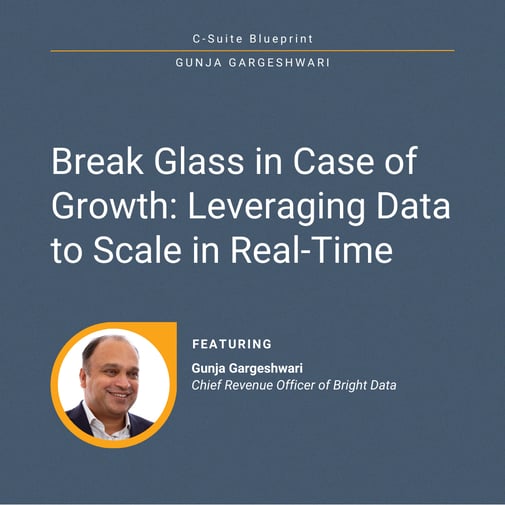C-Suite BluePrint: Decoding Digital Transformation
Why are so many organizations still not leveraging data in real-time, instead merely scratching the surface of their potential to make data-driven decisions?
Gunja Gargeshwari, Chief Revenue Officer of Bright Data, had plenty of thoughts on that issue and other challenges businesses face when trying to harness the full potential of their data.
Gunja talked with us about:
- Building businesses with a customer-centric focus
- “Breaking glass” to reach the next stage of growth
- Why companies struggle to incorporate outside data
Delighting Customers By Leveraging Data-Driven Insights
Gunja's knack for building businesses is evident across his varied roles. At Oracle, AWS, and Zendesk, he consistently turned ideas into profitable ventures.
"A common thread across all of these companies is building businesses within these companies," Gunja said, emphasizing his passion for turning ideas into reality and generating meaningful revenue.
Now, at Bright Data, Gunja is driven by the potential he sees for the company to become a premier data provider, from data collection to analysis and insights.
As for what keeps him motivated as a business builder, Gunja's philosophy centers around a customer-first mentality. What inspires him the most is the transformative impact his services can have on clients' daily operations and the resulting value they can deliver to their customers.
"In the end, what drives you to be a builder is really customer delight... That feeling is amazing," Gunja shared.
When You Have to Break Some Glass to Grow
Gunja offered a fascinating perspective when the conversation turned to the prospect of scaling a stand-alone company versus a business-in-a-business model.
He described how most growth stories begin with a strong concept or idea that gradually evolves into a core product, ultimately leading to market engagement.
"Initially, most of these will see product-led growth where you've hit on a certain gap in the market, and there are people interested," he explained.
The challenge, however, is recognizing the plateau in product-led growth and preparing to navigate beyond it — even if it means, in Gunja’s words, “you’ve got to break some glass.”
He believes one way to transition into the next stage is to seek out adjacent spaces to your core offering.
"One of the triggers you need to look for is an adjacent space [for] your core MVP that is very rich," he advised, stating that your "lighthouse" customers may often direct you towards these opportunities.
Transitioning from product-led growth to sales-led growth is another strategy Gunja emphasized, advocating for experimentation within the go-to-market organization.
This strategy involves landing with partners and affiliates and building a brand presence well in advance. He argued that many companies overlook the need for partner and affiliate ecosystems during product-led growth, which can lead to delays in pulling these growth triggers.
Gunja stressed the value of implementing feedback mechanisms, saying that a customer advocacy board and bringing in the right people to provide feedback from various channels are critical.
Despite the complexities of the “breaking glass” stages, Gunja underlined the importance of remaining customer and data-driven.
“You have to build a mechanism which is built on trust, data, and the fact that people can relate to what you're saying based on real examples," Gunja says.
Marrying Traditional and External Data
Gunja offered further insight into the challenges companies commonly encounter when it comes to effectively leveraging data.
"You look at your own sales forecast, you look at your own product roadmap, you look at your own marketing data, and that's how traditionally companies have made decisions."
He argued this traditional reliance on internal data often causes companies to resist acknowledging the significance of external data.
"It still hasn't made its way into marrying itself with the traditional data to be driving the insights to be able to make decisions. That's a change for them. It's a change in the way they think, and they almost don't want to believe that data," he explained.
Despite these challenges, Gunja holds an optimistic outlook, saying that the future is one where data utilization will be commonplace.
"The mechanisms exist for them to be able to do that. I see the change accelerating, and I think it’s going to continue to accelerate over the coming years."
He further emphasized the potential of instantly leveraging external data. That included citing the success of Zara, a retailer that specializes in bringing trending fashion to their customers as soon as it leaves the catwalk.
"It's amazing some of the things that real-time decision-making can really help you do," Gunja said.
The Key to Leveraging Data in Real-Time? Always Keep Moving
Gunja ended the conversation with some practical advice for sustaining growth.
"Always keep moving. Never rest on your laurels," he said.
By constantly seeking the next opportunity, the next insight, Gunja believes companies can unlock the true potential of data to drive their business forward.
It's clear that embracing the power of internal and external data is not just an option but a necessity for businesses aiming to thrive in today's data-driven world.
And companies that can navigate this transition and continuously evolve their approach to leveraging data will be poised to lead in their respective industries.
Craving more? You can find this interview and many more by subscribing to C-Suite Blueprint on Apple Podcasts, on Spotify, or here.
